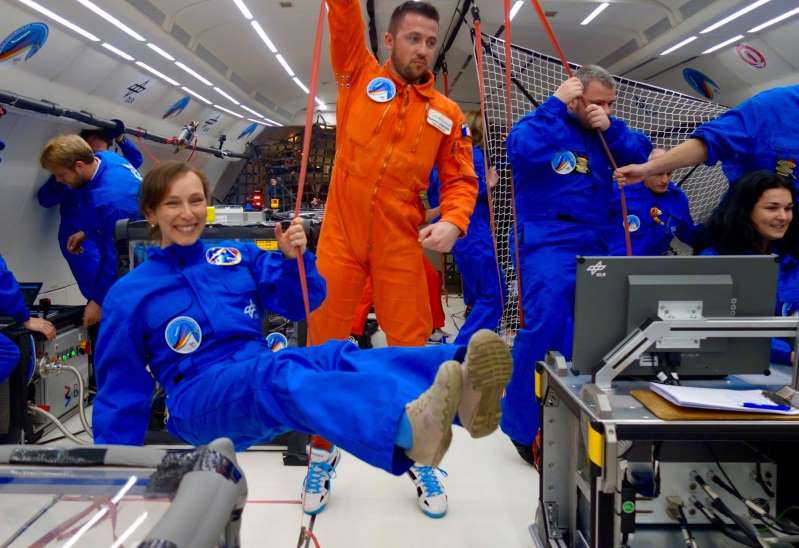For some of the thousands of applicants, the dream of space comes true. A job that demands a lot, but which is also fun.

ESA astronaut Samantha Cristoforetti during training
They go to places that only a few people have seen with their own eyes, withstand extreme loads, are well versed in all natural sciences and live the dream of thousands who look longingly from the earth into the night sky: only about 550 people have ever been in the Space and are therefore astronauts. A goal that seems out of reach for many.
“These are not all superheroes, but normal people who achieve extraordinary things. The prerequisites are not that high – the challenges at work are high, but you can learn that,” says Dagmar Boos, Head of the Center for Personnel Skills and Policy at the ESA, in conversation with futurezone. The ESA is currently looking for new candidates for the profession.
The last call in 2008 received 8,400 applicants. Only 7 of them made it into the current astronaut corps. Last year, 12,000 applicants responded to an appeal by NASA. Nonetheless, Boos says: “You shouldn't be afraid of it. You can't go wrong and should pursue your dream.”
Most important skill: social skills
If you meet the basic requirements, the selection process starts. 6 selection rounds with technical discussions as well as medical, physical and psychometric tests take place over 18 months. Social skills are particularly important. “On the ISS you live with a small team in a very confined space. You depend on each other and on the people on the ground. We need people who can find solutions together even in difficult situations,” explains Boos.
But not only being together can be nerve-wracking, but isolation too. The missions on the ISS often last several months. The German astronaut Alexander Gerst completed around two long-term missions and spent a total of 362 days in space. During this time you have to be able to do without family and friends.
“Such a situation is not easy. Especially during the pandemic we see how difficult it is on the one hand to be isolated and on the other hand to live and work with others in a confined space. That is required of astronauts. But they cannot just call home, “says Boos, describing the challenging situation. Therefore, the social competence and mental resilience are tested very intensively during the selection process.
Theory and action
After the selection, the one-year basic training begins. This is designed so that all astronauts come to the ISS with the same skills and knowledge. The annual program has it all: pilot's license, diving license, training in weightlessness, theory in physics, robotics and mechanical engineering and language learning. “It's very intense. You have to enjoy learning and practicing, but that's also fun,” explains Boos.
Suzanna Randall can confirm that too. The astrophysicist has just finished her basic training. It was surprising to her how much knowledge one actually has to acquire: “You always imagine it to be so action-packed, but a large part of it consists of theory,” she says in an interview with futurezone.
Above all, she loves flying: “The greatest experience was experiencing gravity in parabolic flights,” she recalls. An airplane flies steeply up and down in a zig-zag. During the transition from ascent to descent you float.

Suzanna Randall from
All-round talents
After tests, exercises and basic training follows: even more training. Because the astronauts then have to prepare for their expedition with the basic requirements they have gained. “What defines astronauts is that they are often all-rounders,” explains Randall. This includes, for example, being able to carry out research experiments perfectly on the ISS. NASA astronaut Kate Rubins is currently on the ISS, where she is planting lettuce and radish, harvesting them and sending them back to earth for investigation. In her first mission in 2016, the biologist carried out the first DNA sequencing in weightlessness.
If professional astronauts are not in training or in space, they take on tasks on the ground, such as communicating with the astronauts on the ISS. At ESA, the chances are very good that after completing your training you will definitely be able to fly into space. But the growing global interest in space travel and additional transport options from private companies like SpaceX could require far more astronauts in the future.
New ways to become an astronaut
Suzanna Randall has chosen a new way to make her dream of space come true. In addition to agencies such as ESA, NASA or Roskosmos, private organizations and projects are also starting to offer training. Randall is one of two trainees at Die Astronautin. The non-profit foundation wants to bring the first German woman into space. Randall welcomes this opening up of the astronaut profession. “It's a new path that is becoming more and more accessible. We train on a one-off mission and then return to our jobs,” says the astrophysicist.
It was hoped for the support of the German federal government to raise the 50 million US dollars for a ticket, but so far it has not materialized. To fund the mission, the Foundation is offering its time on the ISS for commercial research. A project is to be carried out together with the German Aerospace Center (DLR). It examines how the eyes change in weightlessness.
Delight girls and women
Another goal of the foundation is to get women and girls more enthusiastic about scientific and technical courses. For this purpose, educational work is carried out to create role models. Together with her colleague Insa Thiele-Eich, Randall recently published the children's book “Our Way into Space”.
ESA is also increasingly appealing to women to apply and is responding to the increasing number of expeditions with an innovation. In addition to the professional astronauts, a reserve team is also selected and trained. After successful basic training, they return to their professions and are on call if a mission site opens.

